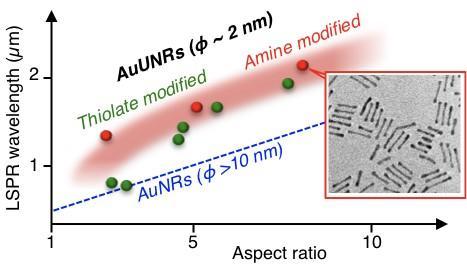Gold Ultrathin Nanorods with Controlled Aspect Ratios and Surface Modifications: Formation Mechanism and Localized Surface Plasmon Resonance.
R. Takahata, S. Yamazoe, K. Koyasu, K. Imura, T. Tsukuda
J. Am. Chem. Soc., Accepted
We synthesized gold ultrathin nanorods (AuUNRs) by slow reductions of gold(I) in the presence of oleylamine (OA) as a surfactant. Transmission electron microscopy revealed that the lengths of AuUNRs were tuned in the range of 5−20 nm while keeping the diameter constant (∼2 nm) by changing the relative concentration of OA and Au(I). It is proposed on the basis of time-resolved optical spectroscopy that AuUNRs are formed via the formation of small (<2 nm) Au spherical clusters followed by their one-dimensional attachment in OA micelles. The surfactant OA on AuUNRs was successfully replaced with glutathionate or dodecanethiolate by the ligand exchange approach. Optical extinction spectroscopy on a series of AuUNRs with different aspect ratios (ARs) revealed a single intense extinction band in the near-IR (NIR) region due to the longitudinal localized surface plasmon resonance (LSPR), the peak position of which is red-shifted with the AR. The NIR bands of AuUNRs with AR < 5 were red-shifted upon the ligand exchange from OA to thiolates, in sharp contrast to the blue shift observed in the conventional Au nanorods and nanospheres (diameter >10 nm). This behavior suggests that the NIR bands of thiolate-protected AuUNRs with AR < 5 are not plasmonic in nature, but are associated with a single-electron excitation between quantized states. The LSPR band was attenuated by thiolate passivation that can be explained by the direct decay of plasmons into an interfacial charge transfer state (chemical interface damping). The LSPR wavelengths of AuUNRs are remarkably longer than those of the conventional AuNRs with the same AR, demonstrating that the miniaturization of the diameter to below ∼2 nm significantly affects the optical response. The red shift of the LSPR band can be ascribed to the increase in the effective mass of electrons in AuUNRs.
